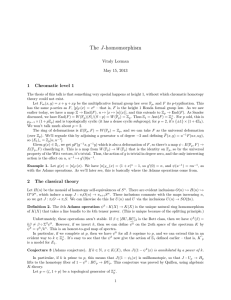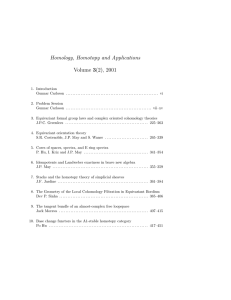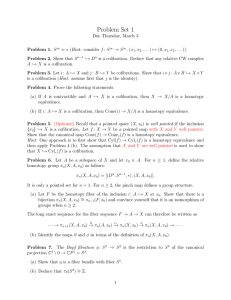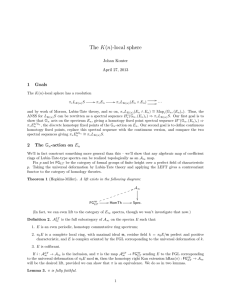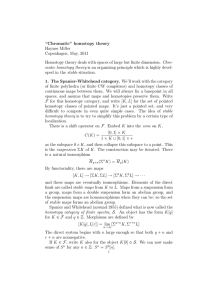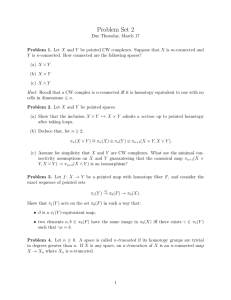Future directions Tyler Lawson April 27, 2013
advertisement
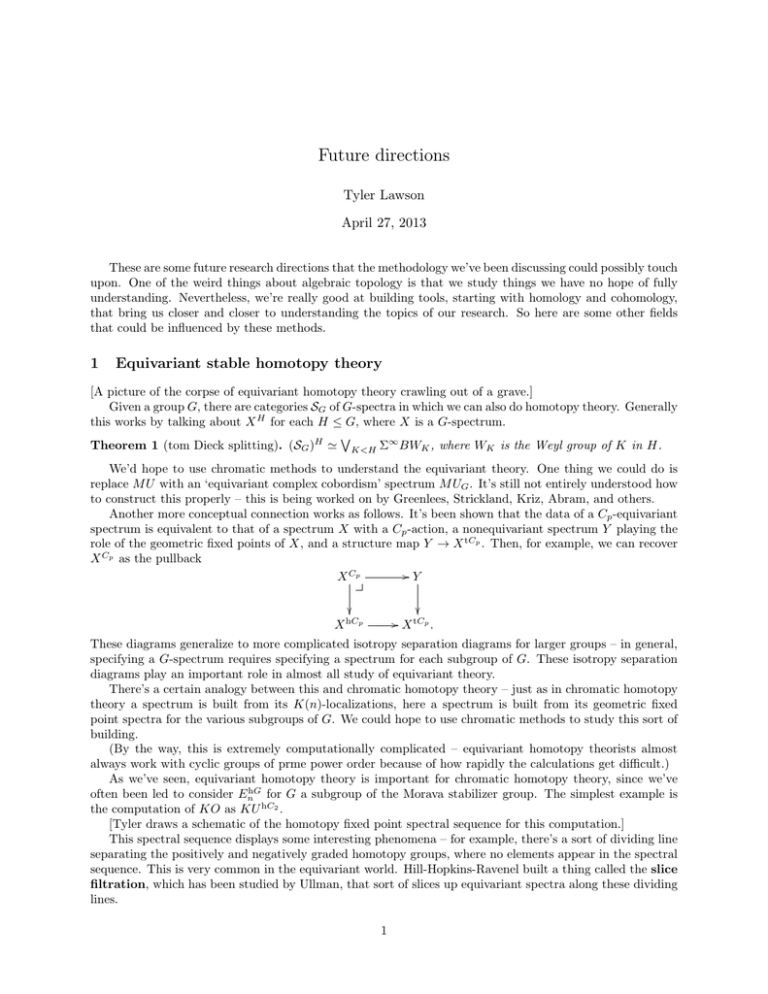
Future directions
Tyler Lawson
April 27, 2013
These are some future research directions that the methodology we’ve been discussing could possibly touch
upon. One of the weird things about algebraic topology is that we study things we have no hope of fully
understanding. Nevertheless, we’re really good at building tools, starting with homology and cohomology,
that bring us closer and closer to understanding the topics of our research. So here are some other fields
that could be influenced by these methods.
1
Equivariant stable homotopy theory
[A picture of the corpse of equivariant homotopy theory crawling out of a grave.]
Given a group G, there are categories SG of G-spectra in which we can also do homotopy theory. Generally
this works by talking about X H for each H ≤ G, where X is a G-spectrum.
W
Theorem 1 (tom Dieck splitting). (SG )H ' K<H Σ∞ BWK , where WK is the Weyl group of K in H.
We’d hope to use chromatic methods to understand the equivariant theory. One thing we could do is
replace M U with an ‘equivariant complex cobordism’ spectrum M UG . It’s still not entirely understood how
to construct this properly – this is being worked on by Greenlees, Strickland, Kriz, Abram, and others.
Another more conceptual connection works as follows. It’s been shown that the data of a Cp -equivariant
spectrum is equivalent to that of a spectrum X with a Cp -action, a nonequivariant spectrum Y playing the
role of the geometric fixed points of X, and a structure map Y → X tCp . Then, for example, we can recover
X Cp as the pullback
/Y
X Cp
X hCp
/ X tCp .
These diagrams generalize to more complicated isotropy separation diagrams for larger groups – in general,
specifying a G-spectrum requires specifying a spectrum for each subgroup of G. These isotropy separation
diagrams play an important role in almost all study of equivariant theory.
There’s a certain analogy between this and chromatic homotopy theory – just as in chromatic homotopy
theory a spectrum is built from its K(n)-localizations, here a spectrum is built from its geometric fixed
point spectra for the various subgroups of G. We could hope to use chromatic methods to study this sort of
building.
(By the way, this is extremely computationally complicated – equivariant homotopy theorists almost
always work with cyclic groups of prme power order because of how rapidly the calculations get difficult.)
As we’ve seen, equivariant homotopy theory is important for chromatic homotopy theory, since we’ve
often been led to consider EnhG for G a subgroup of the Morava stabilizer group. The simplest example is
the computation of KO as KU hC2 .
[Tyler draws a schematic of the homotopy fixed point spectral sequence for this computation.]
This spectral sequence displays some interesting phenomena – for example, there’s a sort of dividing line
separating the positively and negatively graded homotopy groups, where no elements appear in the spectral
sequence. This is very common in the equivariant world. Hill-Hopkins-Ravenel built a thing called the slice
filtration, which has been studied by Ullman, that sort of slices up equivariant spectra along these dividing
lines.
1
2
2
Motivic homotopy theory
[A picture of a Viking longboat moving motivic homotopy theorists across the sea of knowledge.]
This uses categories of ‘motivic stable objects’ that play the role of the stable category but starting
from some sort of schemes rather than spaces. It’s still a very young subject, and we’re only just starting
to understand motivic bordism theory. Morel’s recently computed π0 M GL, which is something called the
Grothendieck-Witt ring and appears to be connected to quadratic forms and the Milnor conjecture. People
are just now starting to compute π1 .
One thing that differentiates motivic stable homotopy theory from standard stable homotopy theory, and
links it with equivariant stable homotopy theory, is that it has a much bigger Picard object: there are now
not only simplicial spheres but also schemey spheres, starting with A1 − {0}. The computations are difficult,
but easier than similar equivariant ones.
We should be interested in computing motivic stable homotopy groups of spheres, but it’s more important
to qualitatively understand the motivic stable category. One thing worth noting about the motivic stable
homotopy groups of spheres is that because of the bigger Picard object, ordinary elements of the stable
homotopy groups of spheres often occur twice, in both ‘topological’ and ‘algebraic’ flavors. For example, η is
no longer 2-torsion, but instead (1 + )-torsion, where is a replacement for one of the 1s. There are likewise
two −1s, which changes how graded-commutativity works, and so on.
3
Algebraic K-theory
[A picture of a dragon burning/redshifting a person with its fire breath]
Algebraic K-theory provides invariants for rings, module categories, ring spectra, and generally anything
giving rise to a symmetric monoidal structure. This has been linked to algebraic topology ever since Quillen
used algebraic topology to define the higher K-groups.
The goal is largely to understand the phenomenology coming from the K-theory functor. One example,
which Sean discussed, is the chromatic redshift conjecture, which roughly says that for R a ring spectrum,
the chromatic information of K(R) is shifted up one level from that of R. We don’t have any conceptual
handle on this – just a tiny bit of empirical evidence for it. So we want to understand what K does from
the chromatic point of view.
Now, K is closely connected to the functor R 7→ BGLn R. So the first question is: is some kind of redshift
visible in BGLn R? In BGL1 R? In gl1 R, the spectrum of units?
Another question is: can we use the universal property of K to detect maps K(R) → K(n), or K(R) →
En ? After all, the targets of such maps are in some sense terminal, i.e. easy to map into?
If K-theory is too difficult to deal with, we can ask the same questions for its friend T C, topological
cyclic homology. There’s a natural map K(R) → T C(R), and T C is known to detect a lot of the information
contained in K. (These functors aren’t homology theories, but for example, the fiber of K → T C is known
to satisfy a Mayer-Vietoris axiom.)
Topological cyclic homology can actually be computed, and so one of our goals should be to compute it.
We start by computing topological Hochschild homology T HH(R), which isn’t too difficult. T HH(R) has
an S 1 -equivariant structure, and for each finite cyclic group Cpn ⊆ S 1 , we can inductively compute fixed
points via pullback squares
T HH(R)Cpn
/ T HH(R)Cpn−1
T HH(R)hCpn
/ T HH(R)tCpn .
We define T Rn (R) = T HH(R)Cpn . There are maps F, R : T Rn → T Rn−1 , with F standing for ‘Frobenius’
and R standing for ‘restriction’ – these are similar to maps that show up in defining Witt rings. We define
T F to be the homotopy limit of the system {T Rn } along the F maps, and T R the homotopy limit along
the R maps. (A side goal is to come up with names that T F and T R stand for.) T C is then computed by
sticking the F map back into T R or vice versa.
4. TRANSCHROMATIC HOMOTOPY THEORY
3
This is all doable, though you theoretically need to produce 1+ 2∞ spectral sequences plus maps between
them. Unfortunately, these spectral sequences are fairly weird. One idea is to figure out the relation between
this and the slice filtration.
A final goal is to compute K(M U ) and T C(M U ). We can describe T HH(M U ) as some sort of Thom
spectrum. This is particularly important because K(M U ) and T C(M U ) fit into a pullback square with K(S)
and T C(S). One inspiring thing (and more evidence for redshift?) is that in some conjectural calculations
1
by Tyler, T HH(M U )tS appears very similar to M U itself.
4
Transchromatic homotopy theory
[A picture of a beer bottle-littered hot tub at the end of a rainbow.]
In large part, we’ve been talking about the K(n)-local category, Morava E-theory, and other things that
are concentrated at a single height. We then expect to reassemble these things via the chromatic spectral
sequence, but we don’t actually really understand how these things are glued together. There are homotopy
pullback squares
/ Ln−1
Ln
LK(n)
/ Ln−1 LK(n)
but we don’t have much information about how these really work. The chromatic splitting conjecture would
supply a little more in the form of a map splitting the square in many circumstances.
Likewise, we don’t really study K(n)-local spectra that often. In general, for any K(n)-local X, we can
talk about its Morava module at height n, given by E ∨ X = LK(n) E∗ X. This has actions of E and of Gn that
are compatible in a certain way, which we can write as an action of an object ‘EhhGn ii’. Morava modules
are ‘complete’ as modules over this object.
For X K(n)-local, there’s a localization functor X 7→ LK(n−1) X, and taking Morava modules gives a
functor from En hhGn ii-modules to En−1 hhGn−1 ii. Current work on transchromatic homotopy theory focuses
on the algebraic study of this functor.
5
Multiplicative theory
We have a smash product of spectra that we use a lot, and one way we use it is to talk about commutative
ring structures, associative ring structures, and intermediate sorts of structures on spectra. It goes without
saying that these are extraordinarily useful – for example, they put multiplicative structures on spectral
sequences, and a highly structured ring structure on R will induce a slightly less highly structured ring
structure on T HH(R), and allows us to define K(R).
Unfortunately, there are relatively very few spectra with commutative ring structures. One example is
∞
the Eilenberg-Mac Lane spectrum HR of a ring R. Another example is Σ∞
+ Ω X for X a spectrum. May
shows in The geometry of iterated loop spaces that having a good multiplication on a space is basically the
same as exhibiting it as an infinite loop space. We can think of Σ∞
+ Y as the ‘group algebra’ S[Y ]. A third
example of ring spectra are Thom spectra, such as M O, M U , and so on.
Now, M U is obviously very interesting from the point of view of chromatic homotopy theory. But so is
BP , and it’s still unknown whether BP admits a commutative ring structure! If we could construct this,
then, for example, we could construct K(BP ). One piece of evidence in favor of this is
Theorem 2 (Bastera-Mandell). BP admits an E4 structure.
Unfortunately, though everybody who cares about this conjecture wants it to be true, nobody really
knows why it should be true. If it were true, some structures would be better than others, since for any
structure we could ask the question whether certain maps we cared about were maps of ring spectra. One
negative piece of evidence is
Theorem 3 (Hu-Kriz). There is no BP -algebra structure on M U .
4
Now, what exactly does E4 get us?
Theorem 4 (Mandell). If R is
• E1 , then R−Mod exists.
• E2 , then R−Mod has a monoidal structure.
• E3 , then this is braided monoidal.
• E4 , then this is symmetric monoidal.
The E∞ structure on M U is critical in the Hill-Hopkins-Ravenel resolution of the Kervaire invariant one
problem, in order to construct the norm map.
[There follows some discussion of various consequences of multiplicative structures, which I wasn’t able
to write down.]

